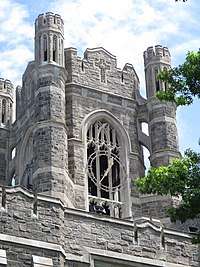Rose Hill campus
The Rose Hill campus is Fordham's original location, established in 1841 by bishop John Hughes. It is home to Fordham College at Rose Hill, the Gabelli School of Business, and a division of the School of Professional and Continuing Studies, as well as the Graduate Schools of Arts and Sciences and Religion and Religious Education.It is the largest of Fordham's three campuses, comprising 85 acres (34.4 ha) in the central Bronx; it is also among the largest privately owned green spaces in New York City, situated just north of the Belmont neighborhood on Fordham Road.[1] The original land comprised 100 acres (40.5 ha), but the university sold 30 acres east of Southern Boulevard to the New York City government to become part of the New York Botanical Garden.
Buildings
Academic and administrative
| Building |
Constructed |
Image |
Notes |
Ref. |
|
| Collins Auditorium | 1904 | 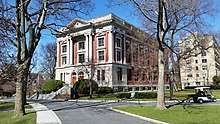 | Home of the university's auditorium and theatre department at Rose Hill, named after President John J. Collins, S.J. | |
| Cunniffe House | 1836 |  | Greek Revival-style administration building, and one of the oldest buildings on the Fordham campus; originally named Rose Hill Manor. Was officially renamed the Cunniffe House in 2013. | [5] |
| Dealy Hall | 1867 |  | Home to the university's psychology and humanities departments; original wing of building constructed in 1867, later expanded in 1891. Named after president Patrick F. Dealy, S.J. in 1935. | |
| Duane Library | 1926 |  | Library named after William J. Duane, S.J., university president 1851–1854. As of 1998, the building no longer operates as a library, but as a multi-use facility for admissions and the university theology department. | |
| Faber Hall | 1963 |  | Seven-story addition to Loyola Hall, originally a residential hall for Jesuits. Headquarters for the modern language department, as well as dorms for first year students. | |
| Freeman Hall | 1930 |  | Building constructed for the physics department, named after science and physics professor Thomas J. A. Freeman, S.J. | |
| Hughes Hall | 1891 |  | Originally constructed in 1891, the building housed the Fordham Preparatory School; was named Hughes Hall in 1935, and now houses the Gabelli School of Business. | |
| Keating Hall | 1936 |  | Four-floor Collegiate Gothic building constructed as the headquarters for the Graduate School of Arts and Sciences. Also houses three auditoriums, the Blue Chapel, and a bell tower. | |
| Kohlmann Hall | 1920 |  | Headquarters for the New York Province of the Society of Jesus and staff house. | |
| Larkin Hall | 1927 |  | Building constructed as headquarters of the biology department, named after president John Larkin, S.J. | |
| Mulcahy Hall | 1969 |  | University's chemistry building, erected as a gift to the university. | |
| Thebaud Hall | 1886 |  | Built in 1886, this building was originally known only as the "science" building. It was later officially designated Thebaud Hall in 1935, named after French Jesuit Augustus Thébaud. Now the headquarters of the financial aid office. | |
| William D. Walsh Family Library | 1997 | 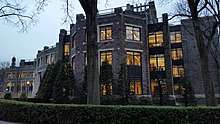 | 1,000,000-volume library constructed in 1998. Ranked in 2004 as the fifth best collegiate library in the country. | [16] |
|
Athletic and outdoor sports facilities
| Building |
Constructed |
Image |
Notes |
Ref. |
| Coffey Field | 1930 | 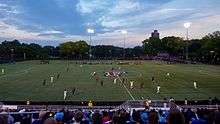 | Football field, named after graduate athletics manager Jack Coffey; refurbished with 7,000 seat grandstand in the 1990s. | |
| Vince Lombardi Memorial Center | 1976 |  | University athletic center and gym, dedicated to Vince Lombardi, alumnus and trustee. | |
| Rose Hill Gymnasium | 1924 | .jpg) | 3,200-seat multi-purpose arena; officially opened on January 16, 1925. | |
|
Residential halls
| Name |
Constructed |
Image |
Notes |
Ref. |
| Campbell, Salice, and Conley Halls | 2009 |  | Three residential halls for upperclassmen. | [19] |
| Faber Hall | 1963 |  | Seven-story addition to Loyola Hall; was originally a residential hall for Jesuits. Renovated in 2016 into a residential dorm for freshmen and transfers, as well as the headquarters for the modern language department. | |
| Finlay Hall | 1913 |  | Originally constructed as the university medical school; after the medical school's closure in 1919, it became a science building. It is now a residence hall primarily for sophomores. | |
| Loschert Hall | 1987 |  | Student residence hall named after William J. Loschert, businessman and alumnus. | [21][22] |
| Loyola Hall | 1936 |  | Built as a residential building for Jesuit faculty members, named after Ignatius Loyola. Now the home of the Manresa program, a freshman honors living community. | |
| Martyrs' Court | 1950 |  | Undergraduate residential hall; named after three Jesuit missionaries martyred in New York in the 17th century: Saint Isaac Jogues, René Goupil, and Jean de Lalande. Jogues houses the first year science living community. | |
| Murray-Weigel Hall | 1922 |  | Residential hall (originally named Messenger of Sacred Heart building) housing Jesuit scholastics. | |
| O'Hare Hall | 2000 | 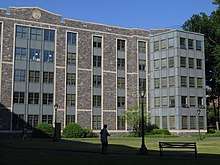 | Three-winged student residential hall housing up to 560 students. Houses upperclassmen living communities. | [24] |
| Queen's Court | 1940 | 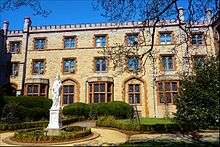 | Residential building for students, consolidated from three separate residences (Bishops' Hall and St. Robert's Hall) in 1940. This dorm contains the first year wellness community. | |
| Spellman Hall | 1946 |  | Three-story Jesuit residential hall, named after Cardinal Francis Spellman. | |
| Tierney Hall | 1986 |  | Three-story student residential hall; originally named Sesquicentennial Hall. Renamed Tierney Hall after the death of William Tierney, class of 1998. | |
| Walsh Hall | 1972 |  | Thirteen-story residential hall for upperclassmen, named after Fordham President Father Michael P. Walsh, S.J. Located along 191st Street. Known as the "555" upon opening. | [28] |
Church facilities
Chapels
| Name |
Location |
Image |
Notes |
Ref. |
| Blue Chapel | Keating Hall | 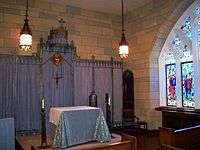 | Memorial chapel located on third floor of Keating Hall, constructed in 1937. Designed with faux stone walls, a faux brick ceiling and dark wood details. Features a blue stained glass window of saints and a Swedish steel altarpiece draped in blue damask fabric. | [31] |
| Our Lady’s Chapel | University Church | N/A | Located in the basement of the University Church. | [32] |
| Sacred Heart Chapel | Dealy Hall | N/A | Chapel located on the ground floor of Dealy Hall. | [32] |
| St. Robert Bellarmine Chapel | Spellman Hall | N/A | Used by the Jesuit community who reside at Spellman Hall. | [32] |
|
Other facilities
| Building |
Constructed |
Image |
Notes |
Ref. |
| Alpha House | c. 1864 | 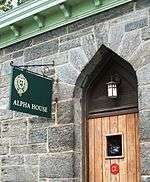 | Cottage housing two seminar rooms for honors society undergraduate students. | |
| Alumni House | 1840 | .jpg) | Second-oldest building on Fordham campus after Cunniffe House; built by William Rodrigue, brother-in-law of John Hughes. Now operates as coffeehouse. | |
| McGinley Center | 1959 |  | Community center adjacent to Rose Hill Gymnasium, housing cafeteria, gym, student lounge, and other multi-use spaces. Named after president Fr. Laurence J. McGinley. | |
| University Cemetery | 1938 |  | 138-plot cemetery where Jesuits, workers, and other clergy are interred. | |
| William Spain Seismic Observatory | 1931 | 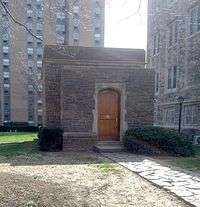 | Seismic observatory named after William Spain, a student of the university who died unexpectedly. Was formerly located in Loyola Hall and Keating Hall before being moved to the building adjacent to Freeman and Keating Halls. | |
|
Lincoln Center campus
In 1954, New York City's Robert Moses proposed that Fordham might "be interested in an alternative [to renting space in the New York Coliseum] involving a new building in a part of the area to the north of Columbus Circle to be redeveloped. In March 1958, Mayor Robert Wagner signed the deeds transferring the Lincoln Center campus to Fordham University.
The Lincoln Center campus is home to Fordham College at Lincoln Center and a division of the School of Professional and Continuing Studies, as well as the School of Law, the Graduate Schools of Education and Social Service, and the Fordham School of Business. The 8-acre (32,000 m2) campus occupies the area from West 60th Street to West 62nd Street between Columbus and Amsterdam Avenues, placing it in the cultural heart of Manhattan.[1] Lincoln Center has two grassy plazas, built one level up from the street. The larger expanse was once a barren cement landscape known as "Robert Moses Plaza;" the smaller is known as "St. Peter's Garden" and contains a memorial to the Fordham students and alumni who perished in the September 11, 2001 attacks.
Buildings
Academic and administrative
| Building |
Constructed |
Image |
Notes |
Ref. |
|
| Leon Lowenstein Building | 1969 |  | Fourteen-story classroom building; also features cafeteria, bookstore, theater, and a lounge on the 12th floor for public speaking and other events. | |
| Law Building | 2011 |  | Home of Fordham's law school. Formerly located in New York's Financial District. An entirely new law school building was finished in 2014, and also houses a residence hall. | [40] |
Residence halls
| Building |
Constructed |
Image |
Notes |
Ref. |
|
| McMahon Hall | 1993 | N/A | Twenty-story residential hall for Lincoln Center students (graduate and undergraduate), named after Father George McMahon, S.J. | |
|
Church facilities
Chapels
| Name |
Location |
Image |
Notes |
Ref. |
| Bl. Rupert Meyer Chapel | Leon Lowenstein Building | N/A | Located on second floor of Lowenstein Building. | [32] |
|
Westchester campus
The Westchester campus is a single, 62,500-square-foot building located in west Harrison, New York.[42] It serves as a branch campus for multiple programs offered at both Rose Hill and Lincoln Center.
References
- 1 2 3 "Fordham Facts". Fordham University. Retrieved April 8, 2017.
- ↑ Mercuri, Joanna (December 2, 2013). "Administration Building Named for Alumni". Fordham News. Retrieved April 9, 2017.
- ↑ Franek, Robert, and Princeton Review. The Best 351 Colleges. 2004 ed. Princeton Review, 2003. Print.
- ↑ Verel, Patrick (November 7, 2010). "Fordham Dedicates Campbell, Salice and Conley Halls". Fordham News. Retrieved April 9, 2017.
- ↑ "The Man - The Building". Fordham University. LibGuides. Retrieved April 13, 2017.
- ↑ "Loschert Hall". Fordham University. Retrieved April 13, 2017.
- ↑ "O'Hare Hall". Fordham University. Retrieved December 29, 2016.
- ↑ "Walsh Hall". Fordham University. Retrieved April 11, 2017.
- ↑ Venturi, Dan. "Fordham University Church". Fordham University. Retrieved December 15, 2013.
- ↑ Sassi, Janet (October 9, 2007). "Rose Hill Chapel Transformed to Reflect Former Glory". Fordham News. Retrieved December 28, 2016.
- 1 2 3 4 "Campus Worship Spaces". Fordham University. Retrieved April 10, 2017.
- ↑ Pogrebin, Robin (September 23, 2014). "New Fordham Building Opens at Lincoln Center". The New York Times. Retrieved April 11, 2017.
- ↑ "Westchester Campus and Facilities". Fordham University. Retrieved April 9, 2017.
External links
|
|---|
| Schools | | |
|---|
| Campuses | |
|---|
| Research | |
|---|
| Buildings | |
|---|
| Culture | |
|---|
| Athletics | |
|---|
| Media | |
|---|














.jpg)













.jpg)



